Lately I’ve been having a lot of conversations around investment terms with searchers, as well as investors.
About 15 years ago, I interned at a search fund. And, over the last few years, I’ve started to invest in the asset class going direct as well as through funds of search funds.
Investing in search funds is a great way to scratch my entrepreneurial itch, extremely rewarding when a searcher finds success, and can be economically rewarding too.
This post is my attempt to share thoughts on self funded search economics in an effort to contribute to the search fund community, get feedback on my thinking from a wider audience, and of course meet more people who are doing searches/investing and may want to collaborate (please feel free to reach out!).
You can watch a video of me explaining this model here, and download the excel here:

Enterprise Value
The standard finance equation is enterprise value = debt + stock – cash. Enterprise value is how much the company itself is worth. Many times people confuse it with how much the stock is worth and find the “minus cash” part of this really confusing.
So, you can rearrange this equation to make it stock = enterprise value – debt + cash. Make more sense now?
Enterprise value is just how much you’re willing to pay for the company (future cash flows, intellectual property, etc), not the balance sheet (debt and cash).
Most investors and searchers think about the EBITDA multiple of a company on an enterprise value basis because they’ll be buying it on a cash free, debt free basis. It becomes second nature to think about EBITDA multiples and know where a given business should fall given scale, industry, etc.
However, I believe this second nature way of thinking of things can be a massive disadvantage to investors given the way EV and multiples are talked about in our community currently.
Sources of capital, the typical way to calculate enterprise value for self funded searchers
If you’ve ever looked at or put together a teaser for a self funded search deal, you will notice that the deal value is equal to the sum of the sources of capital minus deal fees and cash to the balance sheet.
As a simple example, if there is $4 mm of debt to fund the deal, $1 mm of equity, and $200k of deal fees, the enterprise value = $4 mm + $1 mm – 200k = $4.8 mm.
We’ll use slightly more complex numbers in our example: If a searcher is taking a $3.2 mm SBA loan, $850k seller note, putting in $120k themselves, getting $350k of equity from the seller, a $500k earnout, and $1.2 mm of equity financing minus $350k to the balance sheet and $250k of deal fees, then the enterprise value will be $5.62 mm.
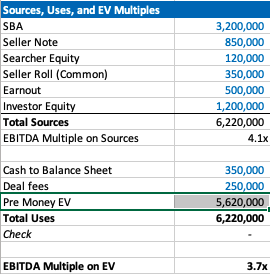
Our example company has $1.5 mm of EBITDA, so the EBITDA multiple is 3.7x. This is a pretty attractive acquisition multiple for a business that meets traditional search criteria (recurring revenues, fragmented competition, high gross margins, low customer concentration, etc).
If you’re seeing a search fund deal for the first time, the headline of “we’re buying a decent company for 3.7x, and replacing a tired owner with a hungry operator” is pretty exciting!
However, if you’re an investor, there is some nuance to this enterprise value number and the true EBITDA multiple you are investing in.
The trick with self funded enterprise value
The security that most self funded search investors get in a deal is participating preferred stock with a paid in kind dividend. This means when there’s an exit, you get your money back before any other equity holder, then get a certain percent of the business, and whatever dividend you’ve been owed in the interim accrues to your principle.
It’s a really favorable security for the investor, and one that is basically impossible to get in VC where straight preferred stock is much more common (no pun intended).
The key terms are what percent of common equity does this security convert into after the originally principal is paid back, and what is the dividend.
The share of common equity the investor group will get typically ranges from 10-50% of the total common stock. The dividend rate is usually 3-15%. The average I’m seeing now is around 30% and 10% for common and dividends respectively.
The strange this about the enterprise value quoted to investors in a teaser/CIM is that it doesn’t change as the percent of common changes, even though this has large implications for how much the common equity is worth and the value investors receive.
For example, I may get a teaser where the sources of investment – cash to balance sheet – deal fees = $3.7 mm for a $1 mm EBITDA company, which would imply a 3.7X EBITDA multiple. Let’s say the searcher is offering investors 30% of the common and a 10% dividend.
Let’s now say that the searcher is having a tough time raising capital and changes their terms to 35% of common and a 12% dividend. Does the effective enterprise value change for investors? I would argue yes, but I would be surprised to see it changed in the CIM/teaser.
This isn’t a knock on searchers or the search fund community. It’s just kind of how things are done, and I think this is mostly because it’s really hard to think about how the enterprise value has changed in this scenario.
However, the natural way of using EBITDA multiples to think about value for a business that is so common in PE/SMB can be extremely misleading for investors here. You may be thinking 3.7X for this type of business is a great deal! But, what if the security you’re buying gets 5% of the common?
If you’re in our world, you may counter this point by saying most searchers will also supply a projected IRR for investors in their CIM. However, IRR is extremely sensitive to growth rate, margin expansion, and terminal value. While the attractiveness of the security will be reflected, it can be greatly overshadowed by lofty expectations.
To get more clarity and have a slightly different mental model on the effective price investors are paying for this business, let’s go back to basics. Enterprise value should be debt + preferred stock + common stock – cash.
We know the values of each of these numbers, except the common. So, the main question here becomes: how much is the common equity worth?
Calculating value of common equity for self funded search funds
Equity value for most search fund deals = preferred equity from investors + the common equity set aside for the searcher and sometimes also advisors, board, seller.
We know that the preferred equity is investing a certain amount for a certain amount of common equity. The rub is that they are also getting a preference that they can take out before any common equity gets proceeds, and they are getting a dividend.
So, the exercise of valuing the common equity comes down to valuing the preference and dividend.
In my mind, there are three approaches:
- The discount rate method where you take the cash flows you’ll get in the future from the pref/dividends and discount them back at the discount rate of your choice. I am using 30% in my model which I believe accurately compensates investors for the risks they are taking in a small, highly leveraged investment run by an unproven operator. If you believe in efficient markets, this number also fits as it mirrors the historical equity returns as reported by the Stanford report, with a slight discount given this asset class has clearly generated excess returns relative to other assets on a risk adjusted basis, hence interest in these opportunities from an expanding universe of investors.
- The second method is to calculate how much money you’d get from your preference and dividends, taking into account that per the Stanford study around 75% of search funds will be able to pay these sums, and then discount these cash flows back at a rate more in line with public equities (7% in my model). This yields a much higher value to the preference/dividend combo, and therefore lowers the implied value of the common equity.
- The last method is to just say nope, there is no value to the preference and dividend. I need them and require them as an investor, but they are a deal breaker for me if they aren’t there, and therefore they don’t exist in my math. This of course makes no logical sense (you need them, but they also have no value?), but I’ve left it in as I think many investors probably actually think this way and it creates a nice upper bound on the enterprise value. Side note, as with obstinate sellers, jerk investors are usually best avoided.
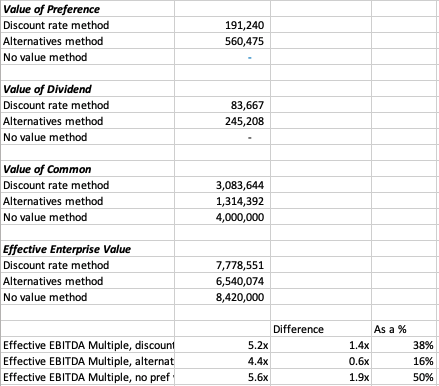
In our example, you can see a breakdown of the preference value, dividend value, and therefore common value and enterprise value for this deal.
In each case, the effective EBITDA multiple moves from 3.7x to something much higher (see the last 3 lines).
There are some simplifying assumptions in the model (no accruing dividend, all paid in last year), and some weird stuff that can happen (if you make the hold time long and the dividend greater than the 7% equity discount rate, the value of the dividend can get really big).
These flaws aside, I think this creates a nice framework to think through what the common is actually worth at close, and therefore what enterprise value investors will be paying in actuality.
It’s worth noting that the whole point of this is to benchmark the value you’re getting relative to market transactions in order to understand where you want to deploy your capital.
This creates a method to translate cash flow or EBITDA multiples of other opportunities on an apples to apples basis (if only there were a magical way to translate the risk associated with each as well!).
Another note, we could calculate the value of the common to be what this asset would trade at market today in a well run auction process minus any obligations (debt, preference, seller financing). However, I think that understates the option value inherent in this equity, a value that is only realized when a new manager takes over with more energy and know how.
There is a finance nerd rational for this. If you plot the value of equity in a leveraged company on a chart, it mirrors the payout of a call option. In both cases, the value of the security increases at a certain inflection point: when the value of equity rises above the strike price in an option, and when the enterprise value of a company rises above the debt level in a levered company.
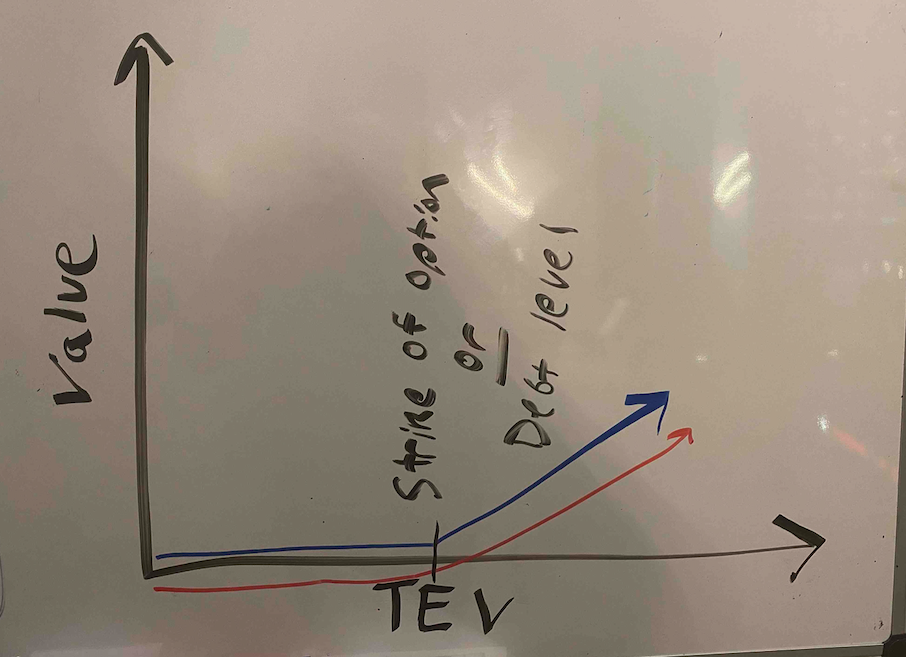
The common equity of a highly levered company can therefore be valued by a similar methodology as the call option: Black Scholes. If you remember back to finance class, increasing volatility will increase the value of an option.
In the search fund case, we’ve (hopefully) increased the (upside) volatility and therefore create more value than simply selling the company today.
A few more thoughts on investor economics
There are a few other ways to think about the economics you get as an investor to best understand if this is the deal for you.
First, you may want to think about how much your investment will be worth day 1. The key lever in this model is what discount this company is being bought for relative to fair market value. For example, the searcher may have proprietary sourced a great company and is buying it for 25% below what it would trade at in a brokered auction.
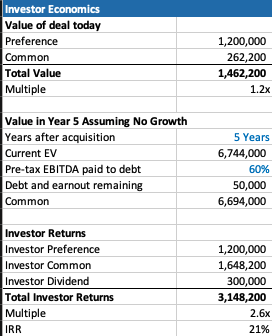
This is very much a “margin of safety” philosophy on things. Same with the calculation on how much you’ll receive in year 5 (after QSBS hits) assuming no growth in the business.
The only problem with each of these calculations is that they never play out in practice. Most companies don’t just stay the same, you’re either in a rising tide or you’re in trouble. And, you’re almost never going to sell in year 1, and definitely not for a slight premium to what it was bought for.
However, if your investment is worth 30% higher day one, and you can make a 20% IRR assuming nothing too crazy happens either way in the business, that’s not a bad place to start. Add in a strong searcher, decent market, some luck, and you’re off to the races.
Thoughts on searcher economics
A lot of this post has considered things from the investor perspective as my main quandary was related to how to create an EBITDA multiple that made sense for investors.
However, the point of this post is not to say searchers are misrepresenting or being unrealistic with their terms. In fact, I think it’s quite logical that self funded searchers capture the massive economic value that they do.
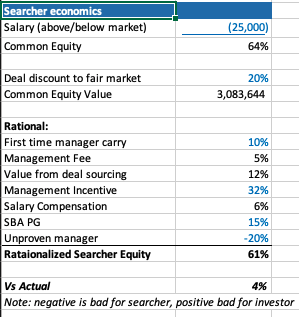
There are many reasons why self funded searchers deserve the lion share of the common equity.
First, they are providing a nice service of giving investors a positive expected value home to park their money with much lower correlation to the market than other asset classes ($1 mm EBITDA companies don’t see lots of multiple contraction/expansion throughout cycles).
Most money managers that fit that criteria are taking a 2/20, of course they also usually have a track record. So, I’ve used a 10% carry in my model, but stuck to 2% annual management fee.
The searcher spent a lot of time, and probably money, finding this company. That’s a lot of value, especially if it’s a below market price. They should be able to capture a lot of the value in finding a below market deal.
The searcher may be taking a below market salary, and needs to get comped like any CEO, with stock options. In my example model I have $1 mm of stock vesting over the hold period, as well as extra comp for taking a below market salary.
Searchers are also usually putting their financial standing at risk by taking a personal guarantee on the bank/SBA loan. This is really tough to put a number on, as is the last line in my framework where searchers are dinged for lack of experience. Like any good model, you need a few lines that you can fudge to make the math work 🙂
What you do think?
I’m shocked that I wrote all this. I was going to type a few paragraphs and a quick excel. However, putting this to paper has been a great exercise for me to sharpen my thinking.
Now I’d like you to help me further. Where do you think this should be changed in this framework? How do you think about things from the investor and/or searcher side?
Feel free to shoot me a note if you have thoughts (even just to tell me I’m being way too academic with this, which I actually agree with).
Lastly, a post like this is really a trap I’m putting on the internet to catch any like minded people in so that we can figure out ways to collaborate now or in the future. So, at the very least, connect with me on LinkedIn 🙂

I’m impressed, I must say. Seldom do I come across a blog that’s
equally educative and amusing, and let me tell you, you’ve hit the nail on the head.
The issue is something that too few people are speaking intelligently about.
I’m very happy that I came across this during my search for something concerning this.
I got this website from my pal who shared with me regarding this site and now
this time I am browsing this web page and reading very informative articles or
reviews at this place.
I’m really enjoying the design and layout of your blog.
It’s a very easy on the eyes which makes it much more pleasant for me to come here and visit
more often. Did you hire out a designer to create your
theme? Exceptional work!
Oh my goodness! Incredible article dude! Thanks, However I am
encountering issues with your RSS. I don’t understand the reason why I am unable to subscribe to it.
Is there anyone else having the same RSS problems? Anyone who knows the solution can you kindly respond?
Thanx!!
Great goods from you, man. I have understand your stuff previous to and
you are just extremely wonderful. I actually like what you’ve acquired here,
really like what you are stating and the way in which you say it.
You make it enjoyable and you still take care of to keep it smart.
I can not wait to read much more from you. This is actually a tremendous site.
You made some really good points there. I checked on the web to
learn more about the issue and found most individuals will go
along with your views on this site.
I enjoy what you guys are usually up too. This sort of clever work and exposure!
Keep up the terrific works guys I’ve incorporated you
guys to blogroll.
Appreciating the dedication you put into your site and detailed information you offer.
It’s good to come across a blog every once in a while that isn’t the same
out of date rehashed information. Fantastic read!
I’ve bookmarked your site and I’m adding your RSS feeds to my
Google account.
Excellent website. Plenty of helpful info here. I am sending
it to a few pals ans also sharing in delicious. And of course, thank you on your effort!
May I simply just say what a comfort to find somebody that really knows what they are talking about over the internet.
You definitely know how to bring a problem to light
and make it important. More and more people must read this and understand this side of your story.
I was surprised you are not more popular because you most
certainly possess the gift.
I will immediately snatch your rss as I can not to find your e-mail subscription link or newsletter service.
Do you’ve any? Kindly let me recognize in order
that I may just subscribe. Thanks.
Just wish to say your article is as astonishing. The clearness for your submit is just cool and that i could suppose
you are knowledgeable in this subject. Well along with your permission let me
to grab your RSS feed to stay updated with coming near near post.
Thanks a million and please carry on the rewarding work.
What’s up, I want to subscribe for this web site to obtain hottest updates, so where can i
do it please help out.
Hi, i read your blog occasionally and i own a similar one and i
was just wondering if you get a lot of spam responses?
If so how do you stop it, any plugin or anything you can recommend?
I get so much lately it’s driving me crazy so any help is very much appreciated.
Pretty! This has been an extremely wonderful post.
Thank you for supplying this information.
Hi, i think that i saw you visited my web site thus i came to go back the prefer?.I am trying to in finding things to enhance my website!I suppose its
adequate to make use of some of your concepts!!
When some one searches for his vital thing, so he/she
wishes to be available that in detail, thus that thing is maintained over here.
Great post. I was checking continuously this weblog
and I’m inspired! Extremely helpful information specifically the final phase :
) I handle such info much. I was looking for this particular information for a very long time.
Thank you and best of luck.
It’s an awesome article in favor of all the web users; they will take benefit from it I am
sure.
Do you have a spam issue on this site; I also am a blogger,
and I was curious about your situation; many of us have developed some nice practices and we are looking to trade techniques
with other folks, be sure to shoot me an email if interested.
You ought to be a part of a contest for one of the greatest blogs
on the web. I will recommend this web site!
This information is priceless. How can I find out
more?
Wow, that’s what I was looking for, what a information! present here at this
webpage, thanks admin of this site.
If some one wants to be updated with most up-to-date technologies then he must be visit this web
page and be up to date every day.
I’m really inspired with your writing abilities as smartly as with the structure on your blog.
Is that this a paid theme or did you customize it
your self? Either way keep up the excellent high quality writing, it’s rare
to look a great blog like this one today..
Whats up are using WordPress for your blog
platform? I’m new to the blog world but I’m trying to get started and create my own.
Do you require any html coding expertise to make your own blog?
Any help would be greatly appreciated!
Very good info. Lucky me I discovered your blog by accident (stumbleupon).
I’ve book marked it for later!
I’d like to find out more? I’d care to find out more details.
Attractive section of content. I just stumbled upon your
site and in accession capital to assert that I acquire in fact enjoyed account your
blog posts. Anyway I will be subscribing to your augment and
even I achievement you access consistently quickly.
Great website. Lots of useful information here.
I am sending it to several pals ans additionally sharing
in delicious. And naturally, thank you to your effort!
Hello! I’m at work surfing around your blog from my new iphone!
Just wanted to say I love reading your blog and look forward to all your posts!
Carry on the outstanding work!
I could not resist commenting. Exceptionally well written!
Hello there, You’ve done an excellent job. I will certainly digg it and personally recommend to
my friends. I’m confident they’ll be benefited from this website.
It’s very easy to find out any matter on web as compared
to textbooks, as I found this paragraph at this web page.
Hello, I enjoy reading through your article post. I like to write a little comment to support you.
Hmm is anyone else experiencing problems with the pictures on this blog loading?
I’m trying to find out if its a problem on my end or if it’s the blog.
Any suggestions would be greatly appreciated.
Wow, awesome weblog layout! How long have you been running a
blog for? you make blogging look easy. The full look of your website is magnificent, as smartly as the
content!
Thanks very interesting blog!
Incredible points. Solid arguments. Keep up the great effort.
Ahaa, its good conversation regarding this paragraph here at this website, I
have read all that, so now me also commenting here.
This excellent website certainly has all of the info I wanted about this subject and didn’t know who to ask.
Thanks , I have just been searching for information approximately this
topic for ages and yours is the best I’ve came upon so far.
However, what about the bottom line? Are you sure concerning the
source?
Pretty nice post. I just stumbled upon your weblog and wanted to say that I have really
loved browsing your weblog posts. In any case I will be
subscribing on your feed and I hope you write again very soon!
Unquestionably believe that which you stated.
Your favorite reason seemed to be on the internet the simplest thing to
be aware of. I say to you, I certainly get annoyed
while people think about worries that they just don’t know about.
You managed to hit the nail upon the top and also defined out the whole thing without having side effect
, people can take a signal. Will probably be back to get more.
Thanks
Does your website have a contact page? I’m having trouble locating it but, I’d
like to shoot you an e-mail. I’ve got some suggestions for
your blog you might be interested in hearing. Either way, great
website and I look forward to seeing it grow over time.
Hey there! This post could not be written any better! Reading
this post reminds me of my previous room mate! He always kept talking about this.
I will forward this article to him. Pretty sure he will have a good
read. Many thanks for sharing!
Excellent blog you have here but I was wondering if
you knew of any message boards that cover the same topics talked about in this article?
I’d really love to be a part of community where
I can get suggestions from other knowledgeable individuals that share the
same interest. If you have any recommendations, please let me know.
Thanks a lot!
What a data of un-ambiguity and preserveness of valuable familiarity concerning unpredicted emotions.
This piece of writing will help the internet people for setting up new website or even a blog from start to end.
Hi there, the whole thing is going well here and ofcourse every one is sharing data,
that’s in fact excellent, keep up writing.